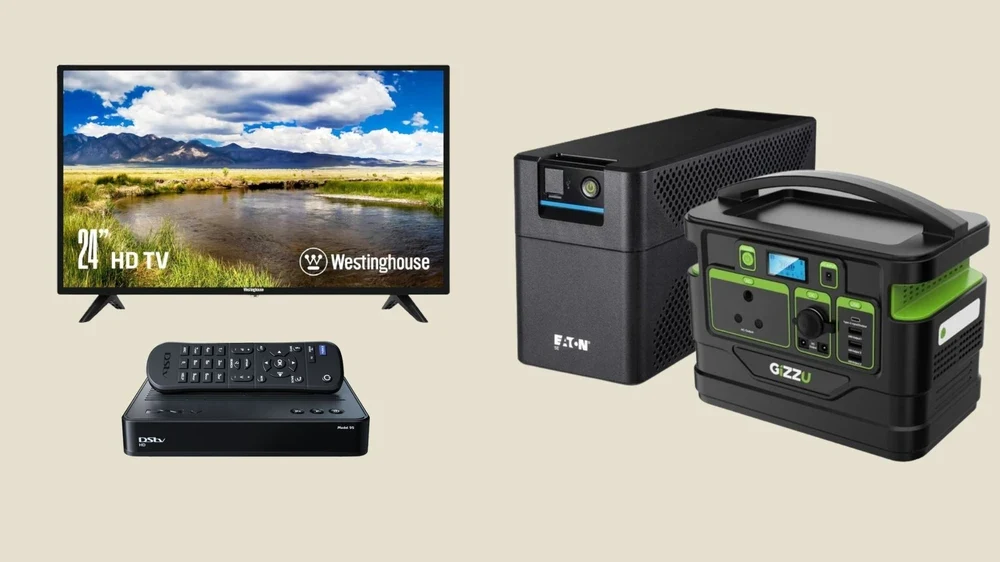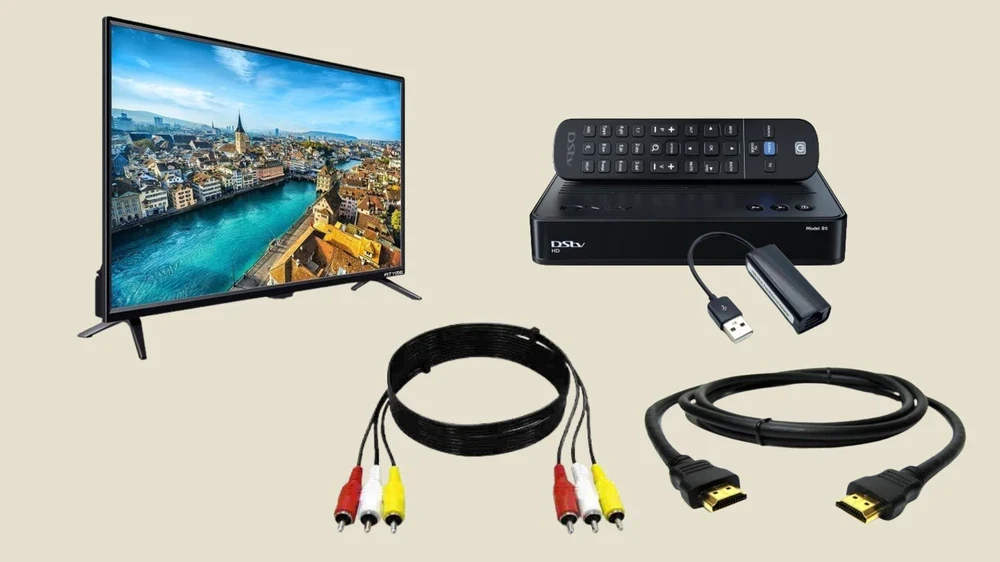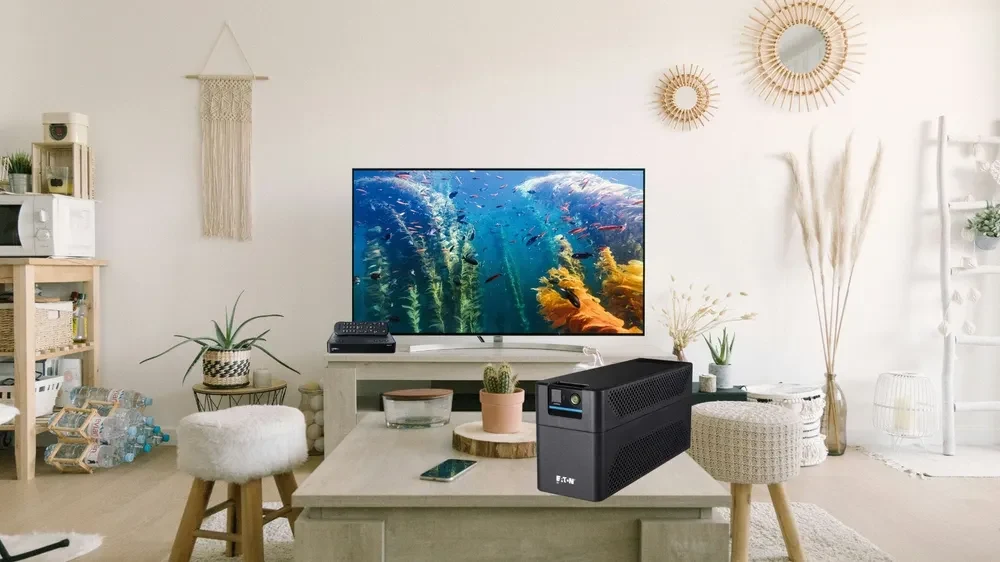Experiencing an outage while enjoying your favorite TV show can be incredibly annoying, which is why having a backup power supply like an inverter can be a smart investment. A reliable Uninterruptible Power Supply (UPS) can make a huge difference, especially during load shedding or if your DSTV is prone to frequent outages.
The UPS, acting as an inverter, provides backup power to your TV or DSTV in the event of load shedding or power failure, ensuring that your entertainment remains uninterrupted.
DSTV decoders, in particular, are very sensitive to power interruptions. Having a UPS for your DSTV can prevent unforeseen disruptions and possibly extend the lifespan of your device. Remember that when selecting a UPS, it’s important to consider factors such as power capacity, battery life, and brand reputation to ensure you are getting the most benefit
Understanding UPS for TV and DSTV

Personal needs, as well as the typical duration of the expected load shedding, should guide the decision on whether to invest in a backup power supply or a battery backup for essential devices. However, a UPS for a TV and DSTV setup typically already includes an inverter and a battery backup.
The inverter converts the direct current (DC) power stored in the batteries into alternating current (AC), which is commonly used to power household appliances such as TVs and DSTV decoders.
During a power failure, the UPS automatically switches to the battery backup and starts providing power to the connected devices. The size of the battery backup determines how long the UPS can provide power during a power outage. The larger the battery capacity, the longer the duration of backup power you can expect.
For instance, a UPS with a 12V lead acid battery can potentially provide backup power for a couple of hours, depending on the power demand of your TV and DSTV decoder. It’s also worth noting that the batteries serve as a reliable backup power source during power outages, ensuring uninterrupted operation of the TV and DSTV decoder.
How to Select the Right Inverter
It’s important to double-check the capacity before making a purchase. An inverter or UPS not only serves as your backup power supply during a power failure, but can also help keep your DSTV decoder, TV, and other important electronic devices running.
Remember that the amount of backup time is determined by the size of the connected battery bank and the load of your equipment. Most power backup systems come with a built-in battery charger that recharges the batteries and keeps them fully charged until a power failure occurs.
In the case of a power failure, the backup system automatically switches to operate on battery power and will automatically start re-charging the batteries when mains power returns. Keep in mind that while most computers and electronics would seamlessly switch during an outage, it’s always prudent to have a UPS battery backup or inverter, providing an additional level of backup power.
| Benefits of UPS/Inverter | Characteristics of Power Backup Systems |
|---|---|
| Provides backup power during a power failure | Comes with a built-in battery charger |
| Keeps essential devices like TV, DSTV decoder running | Automatically switches to battery power during a power failure |
| Backup time determined by size of connected battery bank and equipment load | Automatically recharges batteries when mains power returns |
The Role of Backup Power During Outages
These systems are equipped with built-in battery chargers that ensure the batteries are continuously recharged and maintained until a power outage occurs. This factor helps in providing reliable backup power for essential devices such as the DSTV decoder and router during periods of load shedding. During power failures, the system automatically switches to battery power, providing uninterrupted power to your equipment.
The amount of backup time provided is typically determined by the size of the connected battery bank and the power demands of the connected equipment. Keeping sensitive equipment like DSTV decoders, routers, and alarm systems operating during load shedding or a power outage is crucial.
Since these devices are often critical for either maintaining network connectivity or ensuring safety, having a reliable backup power source becomes essential. Some backup power solutions even offer plug-and-play convenience, meaning the unit is permanently ready to ensure continuous power supply to your DSTV decoder, router, and other critical devices during a power outage or load shedding.
Essential Features of a Good Power Supply
Having a backup power supply to your TV and DSTV decoder is invaluable, especially in the event of a main power failure or outage. No more annoying interruptions in the middle of your favorite show! In addition to this, a UPS battery backup also serves as an indispensable tool for keeping essential devices such as routers, computer systems, and alarm systems running during power outages.
Another impressive feature of a UPS battery backup is its ability to recharge even when it’s in use. The built-in battery charger ensures that your battery is always fully charged and ready to provide backup power as soon as a power failure occurs.
It can also supply power to your connected equipment during a power outage and automatically start recharging its batteries when the power returns. When purchasing, remember that the amount of backup time a UPS battery can provide is determined by the size of the connected battery bank and the load it bears.
| Benefits of UPS Battery Backup | Functions of UPS Battery Backup |
|---|---|
| Provides backup power to essential devices during power outages | Supplies power to connected equipment during a power outage |
| Prevents interruptions during your favourite show | Automatically starts recharging its batteries when power returns |
| Backup time is determined by the size of the connected battery bank and the load it bears | Can recharge even when it’s in use |
Dealing with Load Shedding Using a UPS
Using an uninterruptible power supply equipped with a strong lithium battery can be one of the most practical energy solutions to invest in. This assures that your viewing experience continues smoothly even before the power returns, thanks to its quick recharge capability and efficient sine wave inverter. It’s not just about keeping your TV and DSTV decoder running; a UPS can be your savior during a power failure or load shedding by keeping essential appliances such as your computer, router, and alarm systems operational.
A Gizzu UPS, for example, operates on a lithium battery that seamlessly switches to provide backup power during a power outage, ensuring continuous sine wave energy supply to your devices. Your computer won’t even blink, let alone reset, during the swap.
In essence, a UPS is an ideal solution for power reliability. The amount of backup power it provides during a power outage is determined by the size of the connected battery and the load
Battery Backup: Your Solution to Power Failure
The fully charged battery of an inverter provides a reliable source during load shedding, ensuring uninterrupted operation in case of a power failure. It takes the direct current power stored in the battery and converts it into the alternating current power that powers most home appliances.
In the event of a power outage, the UPS system kicks into action, breaking the dependence on mains supply. The unit is permanently connected to your equipment and a battery bank, and automatically switches to the backup power if a power failure is detected. This instantaneous switch ensures that your equipment remains powered and your activities remain uninterrupted.
The size and type of the connected battery bank determine the amount of backup time available. Thus, more extensive or additional batteries will provide a longer backup time. Computers and other sensitive equipment like routers and DSTV decoders can be backed up using these systems. It’s important to note that a very small percentage of computers could reset during the switchover time, depending on their specifications and the power they draw, particularly in case of a power failure or during load shedding if not equipped with a fully charged inverter or UPS.
| Inverter Function | UPS System Function |
|---|---|
| Converts DC power from battery into AC power for home appliances | Automatically switches to backup power in the event of power failure |
| Provides power during loadshedding | Ensures uninterrupted operation of equipment |
| Size and type of battery determines backup time | Small percentage of computers could reset during switchover time |
Maximizing Your DSTV Decoder During Power Outages

It’s necessary to analyze the amount of power your equipment needs to ensure that in case of a power failure, the backup system can continue to provide ample power to the equipment. For instance, a standard UPS might suffice for a typical DSTV decoder.
However, if you have additional devices, such as TVs, routers, or gaming consoles, you might require a more robust system. It’s also crucial to consider the load-shedding duration and how long you want your devices to stay powered. The charm of a UPS system lies in its seamless operation. Once set up, the system remains permanently connected to your equipment.
In the event of a power failure, the system automatically switches to battery power to keep your devices running. Aside from ensuring continuous entertainment, this immediate switch also protects your electronics from sudden power surges or drops, which could potentially harm their internal components.
Similarly, inverters offer a great solution for power backup. The size of the connected battery bank determines the backup time, and in the event of a power failure the backup system will continue to provide power to essential equipment like the TV and DSTV decoder.
How to Shop for the Right UPS Online
A highly recommended appliance to include in your power backup plans is the inverter, as it can provide enough power for your TVs. The duration of this power is determined by the size of the connected battery, which can be as large as 200ah. It can act as a power supply for multiple electronic devices in the event of a power failure, ensuring uninterrupted use of equipment such as your TV and DSTV decoder.
The power supply capacity of the inverter depends on its size and the amount of load it can handle. A sine wave inverter offering 1000W capacity is a good choice, for example.
Another important aspect of a UPS or inverter system is its ability to automatically start recharging the batteries after the power returns. The built-in battery charger facilitates this process, keeping your equipment up and running even during extended outages.
The recharge time for the batteries, however, does depend on how much power was consumed during the outage. One of the notable features of any reliable power backup system is its ability to switch from the main power supply to the connected battery.
Benefits of a Sine Wave Inverter System

When an unexpected power failure sets in, you risk losing all unsaved work data and interrupting your live stream – a scenario that is far from ideal. With a Sine Wave Inverter System in place, the unit automatically switches to backup power during a power failure.
It is essential to note that the duration of backup time is primarily determined by the size of the connected battery bank and the load on the system (e.g. a TV and DSTV decoder running simultaneously would consume more power than a singular device.)
The built-in battery charger ensures the batteries are kept fully charged until a power failure occurs, at which point it provides power to the equipment. Once the power returns, the whole procedure is reversed, and the unit will switch back to the 12v lead acid battery, ensuring the online UPS stays operational.
The Relationship Between Lithium Battery and UPS
When it comes to Uninterruptible Power Supply (UPS) systems, the introduction of lithium batteries has brought significant development. This is most noticeable in its built-in battery charger that recharges the batteries and keeps the connected battery bank always ready to supply power to important devices like alarm systems. A UPS, which offers emergency power when the primary power fails, generally employs lead-acid batteries.
The use of lithium batteries, known for their superior energy density and longevity, has become increasingly popular. These batteries boost the UPS’s performance by providing a continuous power supply.
This is achieved thanks to a built-in battery charger that replenishes them, managing a balance between the battery backup and the load. A common example of this can be observed in alarm systems, where the installation of lithium batteries ensures uninterrupted operation, even during power outages.
Despite their advantages, there are challenges associated with lithium batteries, such as higher initial costs and intricate management systems. This necessitates continual improvements in lithium battery technology for efficient UPS applications
Lithium Batteries in UPS Systems
- Lithium batteries have been introduced in Uninterruptible Power Supply (UPS) systems, significantly improving their performance.
- These batteries are known for their superior energy density and longevity, making them increasingly popular in UPS systems.
- A built-in battery charger in UPS systems keeps the lithium batteries replenished, ensuring a continuous power supply to important devices like alarm systems.
- Despite their benefits, lithium batteries also pose challenges such as higher initial costs and complex management systems, necessitating ongoing improvements in lithium battery technology for efficient UPS applications.
Energy Solutions: Navigating through Loadshedding
An uninterruptible power supply (UPS) or inverter can come to your rescue in times of a power outage. These devices provide power to the equipment while also containing a battery that is constantly kept fully charged by a built-in battery charger.
So, in case of a power failure, the system automatically switches to battery power and continues providing power to the connected devices. Once the main power returns, the system reverts to the main power, and the battery charger begins recharging the batteries.
How to Keep Your TV and DSTV Decoder Running During Power Failure

Innovative solutions like an adapter for your DSTV decoder can secure uninterrupted viewing on your TV and DSTV. This plug-and-play equipment remains connected, and will automatically start re-charging the batteries, ensuring your viewing pleasure is without any hitches. These compact devices are designed to begin automatically recharging the batteries as soon as the mains power returns.
The batteries’ recharge time is dependent on the level of depletion they’ve experienced during the outage. These plug-and-play adapters, some of which are compatible with wi-fi systems, are effectively safeguarding other entertainment devices that frequently experience load shedding or power outages. With these energy solutions, continuous entertainment is guaranteed, even in the event of unexpected power failures
Power Outage Solutions
- Adapters for DSTV decoders can ensure uninterrupted viewing even during power failures
- These devices automatically start recharging the batteries as soon as main power returns
- The battery recharge time is dependent on the level of depletion experienced during the power outage
- Some of these adapters are also compatible with hi-fi systems, protecting other entertainment devices






